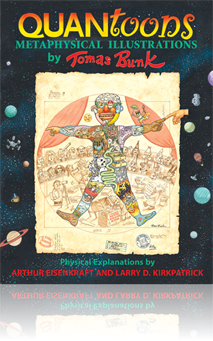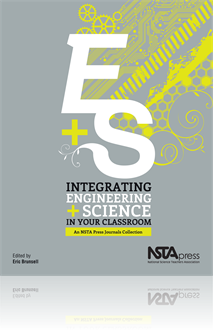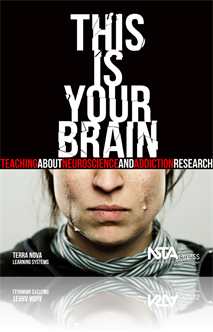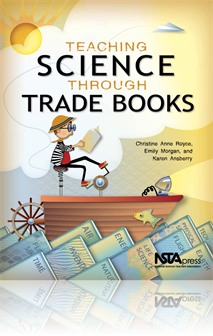All Book Chapters
Book Chapter
Sunsets are some of the most beautiful sights in nature. You might hear people say, “The Sun is ‘going down,’” but that’s not what is actually happening. Have you ever wondered what’s really going on? This sample chapter gives you just a...
Book Chapter
Plants Can Grow Different Parts—How Do Plants Grow?
In this opening sample from How Does a Plant Grow?, curiosity will be ignited! Readers can see how this book will inspire children to be alert to the many wonders of the plant world, from how seeds sprout to why leaves turn to the light to the vital ...
Book Chapter
A man in the band was striking an instrument called a triangle. It made a ringing sound. “That sound reminds me of wind chimes,” said Jane. “The triangle makes a soft ringing sound when it vibrates,” added Jim. ...
Book Chapter
In this sample from Next Time You See a Pill Bug, you can compare the pill bug to the other crustaceans. ...
Book Chapter
Seashells are some of the most beautiful objects found in nature. Have you ever wondered where they come from? ...
Book Chapter
Iron is solid, mercury is liquid, and nitrogen is a gas. Liquid nitrogen is used to perform lots of interesting and fun experiments. Demonstrations exploiting the extreme cold of liquid nitrogen provide entertainment for children of all ages. This ch...
Book Chapter
In response to the national call for more scientists, Steppingstone School for Gifted Education responded by establishing the Steppingstone Magnetic Resonance Training (SMART) Center, which will be described in this chapter. In collaboration with Bru...
Book Chapter
The Promise of Service-Learning as an Instructional Approach to Motivate Interest in STEM Careers
While the promise of service-learning for increasing interest and achievement in mathematics and pursuing mathematical careers is apparent, little research has been conducted to show that the promise can be reached. This chapter provides the results ...
Book Chapter
Real World Externships Exposing Students to Possible Careers in STEM Disciplines
For secondary teachers of mathematics, science, and technology, Real World Externships help them answer the legitimate student query: “Why am I ever gonna need to know this?” with real challenges and problems encountered and solved in actual comp...
Book Chapter
The Talent Marketplace: Where Science Careers Are Made
In this chapter, aspects of science career planning and development are discussed from a different perspective, which at first glance may seem remote and overly theoretical. However, it is the author’s hope that, as the logic of the reasoning unfol...
Book Chapter
Scientists as Partners in K–12 Science: Engineering, Science, and Technology Careers
While scientific specialization has been responsible for many remarkable and rapid advances within scientific disciplines, this strength becomes a weakness when it comes time for members of various disciplines to cooperate. The Iowa Academy of Scienc...
Book Chapter
Science Olympiad: Inspiring the Next Generation of Scientists
As our nation faces a decline in homegrown scientists and engineers, Science Olympiad continues to provide content and experiences that motivate teachers and students to become (and remain) passionate about STEM. Science Olympiad events provide a wea...
Book Chapter
Active Learning as a Way to Interest More Students in Science Careers
In this chapter, the experiences of a science educator and two technology education (TE) classroom teachers are offered. The school is a rural middle school in a Midwestern state where authors collaborated to promote active learning environments, whi...
Book Chapter
Why STEM? Why Now? The Challenge for U.S. Education to Promote STEM Careers
The authors began this chapter with two central questions: (1) Will revitalizing STEM education, especially in America’s high schools, guarantee that graduates will choose STEM pathways in college or STEM careers when they graduate? And (2) Is it w...
Book Chapter
The authors begin the chapter with an assessment of the current state of science teaching and learning in elementary schools. This is followed by an examination of our collaborative work with elementary teachers. The authors describe their approach t...
Book Chapter
NSTA’s Efforts to Interest More K–12 Students in Pursuing STEM Careers
The National Science Teachers Association (NSTA) has inspired and coordinated science education in the United States for 64 years. As the largest professional organization in the world supporting excellence and innovation in science teaching and lear...
Book Chapter
Creating a Pipeline to STEM Careers Through Service-Learning: The AFT Program
The Academy for Future Teachers (AFT) is a STEM education and career recruitment program for Metro Atlanta high school students, hosted by Georgia State University in Atlanta, Georgia. This program was developed in response to the changing demographi...
Book Chapter
Preparing Students for Careers That Do Not Yet Exist
The Illinois Mathematics and Science Academy (IMSA), as a self-described “teaching and learning laboratory for imagination and inquiry,” has a history of pursuing innovations closely aligned with the vision and framework of the National Science E...
Book Chapter
Learning From Successful Cooperative Models
Since some schools lack even a modest representation of free-living animal and plant life, it is important that school districts consider giving high priority to the establishment of cooperative off-campus teaching and research areas for nature studi...
Book Chapter
Listening In on a Naturalist’s Experiences
Field trips that focus primarily on wild nature are one of the quickest ways to start the nature-bonding process. The chapter details a field trip the author conducted in which he used a hands-on approach to get students directly involved, as well as...
Book Chapter
Introduction To Safety In Science
This sample chapter provides an overview of general safety practices for the classroom. Topics discussed are Making Adjustments for Mobility- Impaired Students, Laboratory Safety: Welcome Aboard!, Yes, You Need a Chemical Hygiene Officer, NSTA’s Po...
Book Chapter
Get a Grip! A Middle School Engineering Challenge
Get a Grip! is a problem-based unit that places middle school students in the role of engineers who are challenged to design and construct prosthetic arms for amputees in a war-torn country. The students use common materials to build arms that accomp...
Book Chapter
Science Beyond the Laboratory: The Intriguing Career Paths of 14 Scientists and Engineers
A planetary scientist working on human rights issues? A bird brain researcher hosting a radio show? In this chapter, the authors present vignettes of real scientists who found themselves traveling unique career paths that put them in jobs they didn�...
Book Chapter
Changes Needed in Science Education for Attracting More Students to STEM Careers
Dr. Alberts’s editorials—Why I Became a Scientist; On Becoming a Scientist; Prioritizing Science Education; Reframing Science Standards; and An Education That Inspires—provide a “setting” for meeting Goal Four of the NSES, encouraging more ...
Book Chapter
Designed to Invent: Camp Invention, A 21st-Century Program
With the support of foundations and corporations, Invent Now works to provide programs for all children, including traditionally underrepresented groups such as girls, minorities, inner-city youth, and families who lack the financial resources to pay...
Book Chapter
Educating Students About Careers in Science: Why It Matters
In this chapter, the authors’ analyze why school science needs to attend more to educating students about opportunities for scientific careers. The arguments of this chapter are twofold: (1) School science education fails to recognize what it is ab...
Book Chapter
Ensuring The Ethical Conduct of Research
In this lesson, students explore the federal regulations and guidelines that have been established to help ensure the correct treatment of animals, such as the Animal Welfare Act (AWA). Students discuss acceptable and unacceptable research activities...
Book Chapter
Do you remember your amazement the first time you watched a Mexican jumping bean hop around in the palm of your hand? Investigating "jumping beans" is a unique way to get your students engaged in scientific inquiry. In this chapter, students invest...
Book Chapter
Depending on you location, you may get to experience different seasons–thus meaning your environment changes. Students can begin to make initial observations about an area and then follow this area through the changes that occur over the course of ...
Book Chapter
Invention assists students in understanding the relationships between the individual subjects of STEM education (science, technology, engineering, and mathematics). The playful nature of this chapter's trade books adds that additional spark of creati...
Book Chapter
In today’s world of short attention spans and media overload, the ability to create visual representations to communicate data is an important skill. This lessons, in this chapter, focus on various ways to display data and the purpose of visual r...
Book Chapter
How Do Drugs Affect the Brain?
In this lesson, students continue to follow the story of Chris through the process of the scientific method as they gather important information about brain function and drug use. Students will also be challenged to develop an explanation of why drug...
Book Chapter
In this lesson, students are introduced to a teenager named Chris, whose story unfolds with each subsequent lesson. The only known fact about Chris is contained in a headline, challenging students to begin thinking like scientists about this hypothet...
Book Chapter
Thinking About the Future of Research
In this lesson, students look toward the future of research, specifically animal research. Students discover alternative methods to animal research and what role these methods might play in the future. Students come to realize that animals will conti...
Book Chapter
In this lesson, students explore the importance of the scientific method and how it applies to both historic scientific discoveries and our every- day lives. The story of Chris continues to unfold as students follow the step-by-step process of the sc...
Book Chapter
In this lesson, students continue the process of inquiry as they follow the steps of the scientific method. Through exploration and discovery, they identify regions and functions of the brain and explore how the brain sends and receives messages. The...
Book Chapter
In this lesson, students explore four categories of neuroscience research—specifically, four approaches that are helping to understand drug addiction—basic biological research, population-based research, behavioral research, and genetic research....
Book Chapter
In this lesson, students work in small groups to analyze and sort a variety of research discoveries. This unit illustrates in part the historical role animals have played in medical research. Students sort these discoveries into several categories, i...
Book Chapter
In this lesson, students look at and clarify their understanding of the concept of ethics. In the first activity, students develop a definition for ethics based on their prior knowledge. Then as a class, students explore the meaning of five key ethic...
Book Chapter
In this lesson, students explore ethical considerations in research, focusing specifically on the example of the inclusion of animals in medical research. They work in small groups to analyze the possible harms and benefits to both humans and animals...














